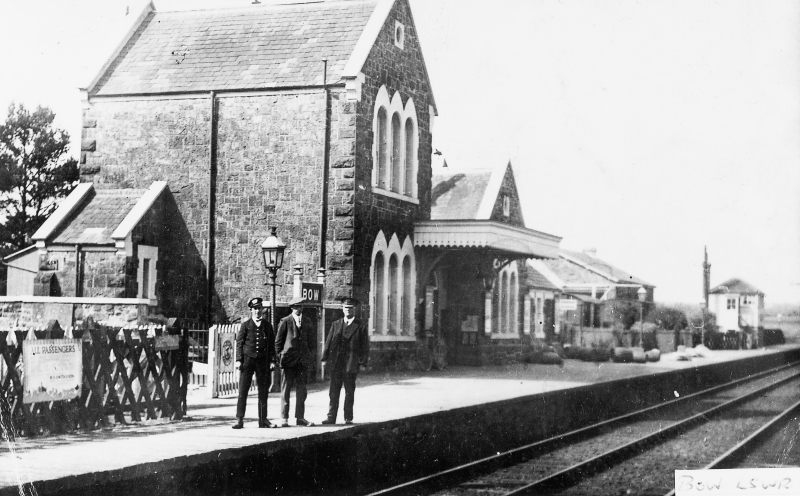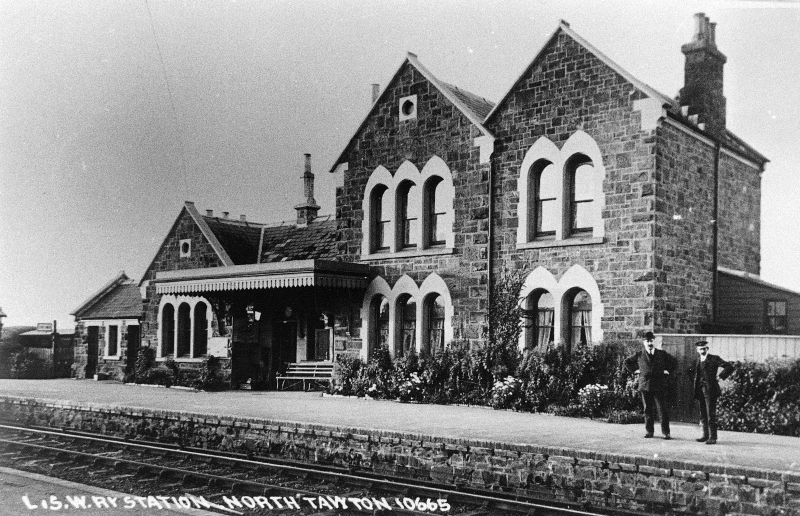150 Years of Railways in Bow and North Tawton
[The following is the text of the brochure produced for the 150th anniversary, written by Philip Wagstaff]
It was 150 years ago, on 1st November 1865, that the railway came to Bow and North Tawton. The Okehampton Railway was authorised on the 17th July 1862. The company was renamed as the Devon and Cornwall Railway in 1864 and the line was built in stages with trains reaching Sampford Courtenay (later renamed Okehampton Road and later Belstone Corner) in 1867. The rest of the line to Okehampton took longer to build. Train services began to Okehampton on 3rd October 1871 and the Devon and Cornwall Railway became part of the London and South Western Railway (LSWR) a year later in 1872.
As befits such an occasion of the opening of a railway in, or in many cases near to, the towns and villages on the line there was great celebration. The railway brought with it a new opportunity to travel and also goods which previously were limited to the speed of horse drawn transport could now be sent to markets many miles away.
The line itself was part of a longer line which was eventually to link Exeter Queen Street (which many years later was to be renamed Exeter Central) with Plymouth Friary and back along to Waterloo via Honiton and Salisbury. The line was originally operated by the LSWR which was later to become part of the Southern Railway. The line was in competition with the Great Western Railway (GWR) and was deep into their territory. The GWR line was from London Paddington to Plymouth North Road and on into Cornwall, passing through the small communities of Dawlish and Teignmouth which were to be changed by the coming of the railway to become holiday destinations.
 Bow station during the LSWR period (photo courtesy of Nicholas & Reeve, Irwell Press) |
But the GWR did not have it all its own way. The LSWR route (of which the line from Crediton to Bow and North Tawton is a part), became part of the Southern Railway’s (later, Southern Region of BR on nationalisation in 1947) ‘Withered Arm’, so called because it reached into the West Country far from the Southern’s major routes to the South coast and the commuter routes around London.
The LSWR was to develop a network of lines which was to exploit the holiday market in North Devon. Of course the GWR was not far behind with lines to Minehead and Barnstaple via Taunton. The ‘Withered Arm’ though did go to Bude and Ilfracombe and joined up at Barnstaple with another unique part of the Southern Railway, the Lynton and Barnstaple narrow gauge railway.
Before the age of the car, and in direct competition with the GWR, the Southern ran trains from Waterloo which had through carriages for many North Devon destinations. Due to the conventions of the time many a single carriage had both first and third class as it trundled through the North Devon countryside. Through carriages from Waterloo to places such as Ilfracombe, Torrington, Bude, Padstow and Plymouth necessitated much shunting at Exeter, Barnstaple Junction, and Halwill Junction in particular.
Even though the Southern Railway’s headquarters were a long way away from Devon there was still continuing innovation and the last line in the area opened on July 27th 1925 linking Halwill Junction with Torrington. This line was built by Colonel Stephens as a light railway and subject to 25mph speed restriction.
The current Dartmoor Railway was part of the Southern’s ‘Way to the West’ and as such we are celebrating an important anniversary today. As you travel along the line it is at a much more sedate speed than the expresses such as the Atlantic Coast Express to Plymouth and Padstow, but we are still following the course of the railway itself. The line has few major engineering features and is straight for much of the run from Bow to North Tawton. Like every railway there are many bridges, culverts, cuttings and stations all of which had to be maintained once they were built.
 An early Edwardian photograph of North Tawton with stationmaster W.H. Odam in the bowler hat. (Photo David Howe collection, courtesy of Nicholas & Reeve, Irwell Press) |
The railway took a long time to build and this 150th anniversary celebration, which is taking place to recognise the railway reaching Bow and North Tawton, will be added to in a few year’s time. The line was eventually extended to Meldon Viaduct, the current terminus of the line, in 1874. At Meldon the Southern Railway (and later the Southern Region of British Railways) used stone from Meldon as ballast across the region. Meldon stone (hornfels - shale or mudstone which has been altered by contact with hot igneous rock) was known for its lasting qualities and it was prized across the network. Due to increasing competition the quarry was mothballed in 2011 but the legacy that the quarry has left is the line that we now call the Dartmoor Railway. The railway has changed much through the years but it is still possible to travel the old Southern way into Devon.
With the changes in the railway landscape in the 1960s and the 1970s the line was to close to passenger traffic in June 1972 at which time the stations were also closed. The station buildings at North Tawton have been converted into flats and the station building at Bow is being sympathetically built into a family home, keeping many of the old features of the original station. It is at Bow that we are concentrating our celebrations as that is one of the stations which remains of the original group of stations built along the line.
Thank you for travelling with us today and we trust that you can see something of the way that the opening of the line brought about new opportunities for the communities along the line itself as well as seeing some of the changes that brought about the decline in the railway.
Of course as with any endeavour such as the Dartmoor Railway many people and organisations support the development of the railway today. Granite Line Ltd. and the Dartmoor Railway Supporters’ Association.... ...volunteers, duty managers and the General Manager and all who make the railway happen today. And we are always seeking new volunteers!
For further information:
Bow Station Website.
The Okehampton Line - The Southern Railway Route between Exeter, Tavistock & Plymouth, by John Nicholas and George Reeve (currently out of print, but due to be reprinted soon in a larger, expanded format): Irwell Press.

 Home
Home